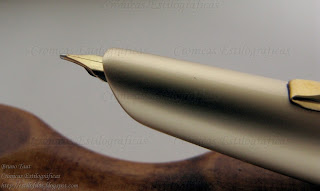And on these texts, I have also mentioned the amazing creations of nibmeister Yamada. Among them, his version of a two-fold nib, based on a Pelikan M800, caught the attention of many of us.
Then, what’s next? Are there more possibilities in our understanding of nibs and pens? Mr. Yamada is indeed creative and daring. And so his question was more concrete, more advanced: What if instead of overlapping the nibs we opposed them?
Here we have a couple of average looking pens: a Senator and a Pelikan (M800). Their nibs, though, have been heavily modified and now are unique and radical. Mr. Yamada did really oppose two nibs, and to do so he had to make special feeds to provide ink to both of them.
These nib sets have the wonderful property of allowing a big number of different strokes, which in turn depend on the geometry and configuration. Needless to say, now there are many more possibilities. Today, I will only speak about the asymmetric configuration.
 On the Senator pen, the lower nib, on the right in the picture, is made of steel. Its bending is quite progressive.
On the Senator pen, the lower nib, on the right in the picture, is made of steel. Its bending is quite progressive.
The Senator pen in the hands of its creator, Mr. Yamada. Please, note the variety of lines.
On it, one of the nibs is mostly untouched and the other is bended about 45 degrees in a quite sharp angle. The result is a wet fine point —fed by two slits— when writing with the tip. At more shallow angles, though, the whole lower nib draws a very thick line.
 The Pelikan set is formed by two 18 K Pelikan nibs. The lower nib is bended at a much sharper angle than that of the Senator pen.
The Pelikan set is formed by two 18 K Pelikan nibs. The lower nib is bended at a much sharper angle than that of the Senator pen.
The nib set, as in any Pelikan pen, can easily be detached from the section. On the paper, some writing samples of the Pelikan nib. Note the possibility of drawing both thin and very broad lines.
Indeed a versatile nib with lines ranging from very fine to inordinately broad.
On another chronicle I will describe other possibilities.
Hats off to Mr. Yamada!
Pilot Capless 1998 – Sailor Sei-boku
Bruno Taut
May 23-26, 2012
etiquetas: Yamada, plumín, evento, soluciones técnicas, Pelikan, Senator.
Bruno Taut
May 23-26, 2012
etiquetas: Yamada, plumín, evento, soluciones técnicas, Pelikan, Senator.














































